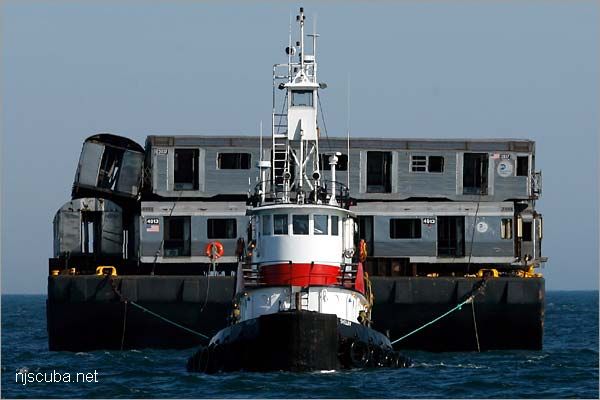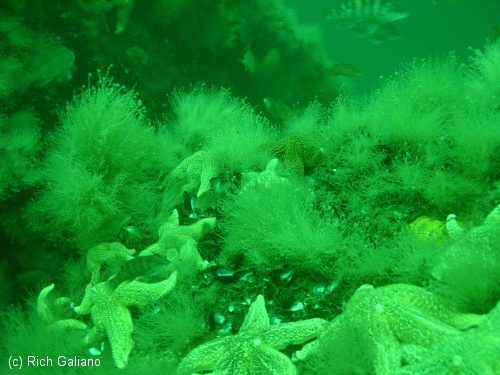DelJerseyLand Artificial Reefs
Depth: 120-140 ft [download]
DelJerseyLand Artificial Reef Inshore
There are a lot of interesting vessels on this reef. It is a shame that no one goes out there, judging from the complete absence of either fishing or diving reports, not even one. In the North Atlantic, any artificial reef more than 15 miles offshore is pure folly. Deepwater Reef is the same.
The Radford is complicated. The bow is where it is marked, and the wreck originally faced southwest. The stern would have originally been close to the Gregory Poole, but I don't know where the stern is now. The mid-section of the wreck walked over to the charted location in Hurricane Irene. A large number of Redbird cars and Brightliners were also sunk in this reef, mostly in the north. There is probably little left of them.
You'd think that this far offshore conditions would be pretty good for diving, but apparently not. Strong currents and bad visibility are a distinct possibility, not unlike the Mud Hole. This reef lies directly in the outflow of the Delaware River.
Building a reef 28 miles offshore serves no one. It is a 2-3 hour drive for a typical dive boat, less for a faster fishing boat, but still a tremendous fuel cost. From the total lack of fishing and diving reports, it is clear this reef site is little used, except perhaps by a select few with money to burn. I look at the vessels below, and all I can think is 'what a shame'. They should have been sunk where people will use them.
This site is not only impractical for fishing and diving - what construction company wants to waste fuel and time hauling material all the way out here? There is no new 'science' here either - reef ecology has been well-studied, and can continue to be studied at other more practical sites.
The is also a DelJerseyLand Offshore reef. This is over 60 miles offshore, and almost 200 feet in depth. This reef appears to be completely undeveloped, and hopefully will stay that way, as any monies or materials used there are completely wasted.
I applaud Delaware's artificial reef program. Artificial reef building is a great business that serves everyone ( and the fish ) when it is done right. But siting a reef out where no one will use it is not right.
This reef is some sixty miles offshore. Hopefully this site will never get used, as no one will ever go out that far. Have you seen the price of fuel lately?
DNREC Creates New Artificial Reef Off Delaware Coast
Retired Navy Vessel Recycled As Home for Fish and Sea Life
(Dec. 10) With the sinking of the Gregory Poole, a retired 175 foot Navy vessel, DNREC created a new artificial reef off the Delaware Coast approximately 26 miles southeast of the Indian River Inlet. The reef will enhance fisheries habitat, increase marine biodiversity and productivity and provide fishing and diving opportunities for decades.
Reef construction is especially important in the Mid-Atlantic region, where the ocean bottom is usually featureless sand or mud. Recycled materials, including concrete pipe and other concrete products, ballasted tire units, subway cars and decommissioned military vehicles and vessels, have been sunk off the Delaware coast. Using these materials saves landfill space and allows them to serve in a productive capacity for hundreds of years past their originally intended use.
Monitoring studies have shown that placement of durable, stable reef materials can result in a 400-fold increase in the amount of small sea life and fish. The materials provide refuge or shelter for small fish, and they are the prey that attracts larger fish. Swift, open-ocean pelagic fish, such as tuna and mackerel, use the reef as a hunting ground to grab a quick meal.
The new reef, DelJerseyLand Inshore Site, lies equal distance from Cape May, N.J., Ocean City, Md. and Indian River Inlet, Del., and will be developed jointly by Delaware, Maryland, and New Jersey as a regional effort. The site, with an area of about one square mile and a depth of 120-130 feet, was permitted in 2006, specifically for surplus Navy vessels.
The Gregory Poole can now give back to the ocean, said Jeffrey Tinsman, reef program manager with DNREC's Fisheries Section. The ship makes an ideal reef because of its voids and cavities, the perfect sanctuary for fish. Within a few weeks, blue mussels, sponges, barnacles and soft corals attach to the structure, and in about a year, the reef will be fully productive, resembling natural habitat.

ERROR: bad category 'deljerseyland-artificial-reef'

